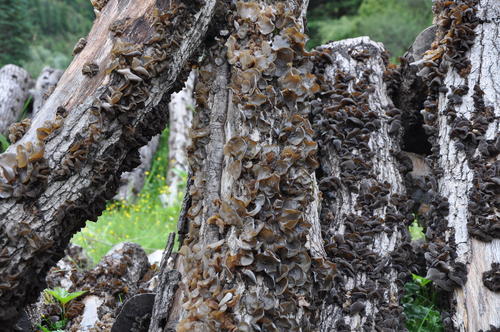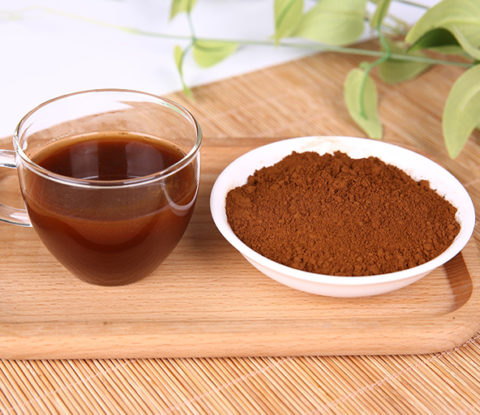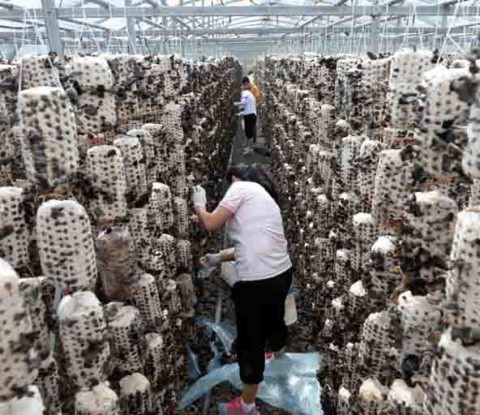
Auricularia Auricula Extract/Black Fungus Extract Powder
[Latin name]: Auricularia auricular
[Part used]: Fruitingbody
[Active ingredient]: Polysaccharides
[Specification]: 10%,20%,30%,50%
[Test method]: UV
[Appearance]: Brownish yellow powder
[Particle size]: 95% pass 80 mesh
 Black Fungus Extract by using Auricularia auricula-judae as the raw material, which is a mushroom known as the Jew’s ear, wood ear, jelly ear or by a number of other common names, is a species of edible Auriculariales fungus found worldwide. The fruiting body is distinguished by its noticeably ear-like shape and brown colouration; it grows upon wood, especially elder. Its specific epithet is derived from the belief thatJudas Iscariot hanged himself from an elder tree; the common name “Judas’s ear” eventually became “Jew’s ear”, while today “jelly ear” and other names are sometimes used. The fungus can be found throughout the year in temperate regions worldwide, where it grows upon both dead and living wood.
Black Fungus Extract by using Auricularia auricula-judae as the raw material, which is a mushroom known as the Jew’s ear, wood ear, jelly ear or by a number of other common names, is a species of edible Auriculariales fungus found worldwide. The fruiting body is distinguished by its noticeably ear-like shape and brown colouration; it grows upon wood, especially elder. Its specific epithet is derived from the belief thatJudas Iscariot hanged himself from an elder tree; the common name “Judas’s ear” eventually became “Jew’s ear”, while today “jelly ear” and other names are sometimes used. The fungus can be found throughout the year in temperate regions worldwide, where it grows upon both dead and living wood.
In the West, A. auricula-judae was used in folk medicine as recently as the 19th century for complaints including sore throats, sore eyes and jaundice, and as an astringent. Although it is not widely consumed in the West, it has long been popular in China, to the extent that Australia exported large volumes to China in the early twentieth century. Today, the fungus is a popular ingredient in many Chinese dishes, such as hot and sour soup, and also used in Chinese medicine. It is also used in Ghana, as a blood tonic. Modern research into possible medical applications have variously concluded that A. auricula-judae has antitumor, hypoglycemic, anticoagulant and cholesterol-lowering properties.
Auricularia auricula-judae is well known as wood ear or tree ear or black fungus. Fruit bodies of Auricularia auricula- judae are rich in carbohydrates, protein and minerals (Ca, P and Fe). Polysaccharides fromAuricularia auricula-judae extract include carbohydrate mainly composed of rhamnose, xylose and glucose and smaller amount of mannose, galactose and arabinose, uronic acids, sulfate groups, N and ash and its active constituents are beta (1-3) and (1-6) D glucans. Polysaccharide and methanol extracts from Auricularia auricula-judae have been reported to have antitumo-r activity, anticoagulant, anti-lipidemic and anti-cholesterol, and antiplatelet aggregation. However, the reports on antitumo-r activities of different solvent fractions of Auricularia auricula-judaeextracts are scarce. Therefore, this study aimed to determine the antitumo-r activity of the solvent fractions of the 70% ethanol extract and compared the effect among the different fractions of Auricularia auricula-judaemushroom and also examined the efficacy of in vitro stronger antitumo-r active solvent fraction against solid tumo-r sarcoma 180 in mice.
Medicinal Properties
Fungi like Auricularia produce many different polysaccharides, which have a variety of functions in the fruit body, and these polysaccharides are sometimes found to stimulate the immune system in humans or in some cases cause the production of interferon and interleukins that then stop the proliferation of cancer cells. They have also been found to have antitumor, cardiovascular and hypocholesterolemia, antiviral, antibacterial and antiparasitic effects.
Auricularia has been used for thousands of years for the treatment of various ailments. It is prepared in a different way for each different group of treatments. For example, hypertension, vascular sclerosis and ophthalmic bleeding are all in one group and rheumatic pains in legs and lumbago are in another. Auricularia has been used over the centuries, to treat weakness after childbirth, cramp and numbness; for pains from injuries, obstruction in arteries and veins, numbness and tetany; for malignant dysentery, piles, and enteritis; for menorrhagia and leucorrhoea; for gastric disorder causing nausea and excessive phlegm; for piles in the aged which will not heal. There must be something that is similar between all these diseases and problems that one mushroom can help with all of them, that is if it truly can. Or maybe there are a few similar elements which different components of Auricularia treat. Whichever it is the research should make it clear if any of these cures have any proof at all. Also it seems that it is necessary to look at the different networks described in the traditional Chinese system to understand why it is claimed to do so much and whether the networks can explain the diversity of its functions.
Pharmacological Actions of Black Fungus Extract
Animal test: hypoglycaemic and hypocholesterolemic abilities of Auricularia
The two things that have been tested in this miracle-curing mushroom are its hypocholesterolemic effect, and its hypoglycaemic effect. There are reports on its effectiveness in reducing the blood glucose levels in KK-Ay mice that are genetically obese and have diabetic syndromes such as, hyperglycemia, hyperinsulinemia, glucosuria and severe insulin resistance. One study limited its attention to the water-soluble polysaccharide extracted from the fruiting bodies of Auricularia and the other examined three different groups of polysaccharides all found in the fruiting body; a mixture of crude polysaccharides, acidic polysaccharide fractions, and neutral polysaccharide fractions.
The first study, on water-soluble polysaccharide, found that black fungus extract polysaccharide extract at the dosage of 3% could reduce the fasting plasma glucose concentration, and also reduced the urinary glucose excretion, and the high serum glucose and insulin after feeding.
The other report found that the black fungus extract polysaccharide improved glucose tolerance to intraperitoneal glucose loading, but did not affect the non-fasting insulin level; that the acidic polysaccharide had no beneficial effects; and that neutral polysaccharides showed dose dependent effects on lowering the fasting and nonfasting glucose and insulin but it did not affect the glucose tolerance.
Discussion on Black Fungus Extract
The evidence from these articles indicates that there is the potential for Auricularia to alleviate the symptoms of non-insulin dependent diabetes. In this disease, the suffer has diabetes because the receptors for insulin on the target cells are desensitized or alternatively there are not enough of them, and so the sufferer has a high blood glucose level but also a high blood insulin level. It is hypothesized that Auricularia can help reduce the blood glucose levels by reducing the emptying time of the stomach. When the polysaccharides found in Auricularia are mixed with water they form a very viscous solution. This increased viscosity could possibly slow the rate of emptying of the gastric contents, decrease the motility of the stomach and the small intestine and so result in a decreased rate of absorption of carbohydrates. As an increase in the rate of glucose absorption has been shown to result in an increase in the speed at which insulin resistance occurs, then it seems logical to think that perhaps the slower the glucose is absorbed the less likely insulin resistance is to develop. Whatever the cause, the polysaccharides lead to a decrease in blood glucose levels and so a decrease is the blood insulin levels and also a decrease in the glucose concentration in the urine.
Auricularia and hypercholesterolemia
The other report looks at the effect of Auricularia on rats fed a hypercholesterolemic diet with or without the addition of Auricularia. The effect after four weeks was a significant decrease in serum cholesterol concentration (17%) and a decrease in the serum LDL cholesterol level (by 24%). The HDL concentrations were not affected and neither was the total liver cholesterol. However the fecal neutral steroids and bile acids were both increased by 39% and 46% respectively. The conclusion of this report is that Auricularia showed hypocholesterolemic activity in the rats. Why Auricularia should do this is unclear but it must in some way stimulate the production of bile acids and fecal neutral steroids and so use up the excess cholesterol in that way, but the actual mechanism of action is not clear.
This property of Auricularia could lead to its use as a preventative for the problems of vascular sclerosis since the likelihood of getting a plaque developing is greatly increased by high levels of LDLs in the blood. The fact that it does not alter the HDLs is also beneficial as HDLs help soak up cholesterol deposits in the blood and so have anti-plaque forming properties as well.
Conclusions on Black Fungus Extract
The scientific proof needed to establish that Auricularia has definite medicinal power is lacking but it can be said that some experiments have been done and it is effective in lowering cholesterol and glucose levels in the blood of both rats and mice respectively. The hypercholesterolemic effect of this mushroom could be why it is said to be a good treatment of obstruction in arteries and veins, vascular sclerosis and hypertension. Since having high levels of cholesterol in the blood stream leads to more deposits in the arteries and veins and can lead to atherosclerosis and so obstruction of the veins and arteries. One of the causes of hypertension is narrowing of the renal arteries and so by decreasing the cholesterol levels in some way, then possibly the narrowing could be put on hold. The effects of Auricularia as shown from the evidence in this report have not been extensively tested. To safeguard against the possibility that the search engine was not returning a representative sample of research papers I searched for two other medicinal mushroom, Lentinula edodes and Ganoderma. The search resulted in 44 and 42 articles being displayed respectively for these, compared with only 2 dealing with Auricularia. This shows that not much research has been done on this mushroom and so stimulated a visit to the nearest Chinese Medicine shop in Manchester, to find out their experience in the use of this mushroom and whether it was popular (panel following).
This experience goes some way towards explaining the lack of research that has been done on this mushroom, because if no one is using it any more then there seems to be little call for any experiments to be done. Why it should have gone out of use is difficult to understand considering its position in traditional treatment of all the diseases it is supposed to be able to help and cure. This may be explained in someway by considering the changes to lifestyle that has come about with the modernisation of China. I suppose that, as people in China progress to a more Western like society, complete with western science and technology, they will necessarily begin to shift their perceptions of the way the body and world function. This would be simply due to having a different education with the emphasis being on different things. I do not know if this is a good thing or a bad thing, who can say whether our idea in the West is superior to the more holistic approach of the far East.
The traditional Chinese medical system and its five different networks did little to help the confusion of the diversity of the treatments and cures claimed of this mushroom. There seemed to be no relationship between the symptoms it was claimed to cure and the networks and so I suppose that maybe there are many complicated systems in their medical practices that I have not found out about and that possibly there is an explanation in the old Chinese literature. Alternatively, although some evidence points towards the fact that it may have some curative effects I was led to consider the possibility of the placebo affect having an impact on the use of it for so long. Research has been done by Ross and Olson (1981) on patients’ expectations and how these influence the process of becoming well again. It is known that changes in the state of an illness is almost always attributed to the drug that is being taken whether it is responsible or not. These findings indicate that perhaps the claims made of Auricularia are more to do with what people wish to believe compared to that which is actually true.
The objective behind this report was to look at the evidence that is available about Auricularia and determine whether there is any scientific proof supporting the claims made of it. It is clear that there is little experimental evidence as to whether it contains the ability to treat those diseases it is reported to cure, but it is impossible to even speculate as to what experiments were done in the past in China. This report seems to suggest that the lack of scientific analysis into Auricularia is due to decreased popularity rather than any ridiculous claims for its properties. This report has shown that although these herbs and mushrooms may have beneficial attributes it is unwise to rely on them if no tests and experiments prove that there is science that can back up the beliefs.
The evidence gathered on Auricularia shows that it may have some potential in the management of non-insulin dependent diabetes and that it could possibly be a preventative for atherosclerosis. This however is assuming a lot about it, as it has only shown these attributes in respect to rats and mice and the assumption that the same is true of humans is not correct. No matter what the true medicinal value of Auricularia may be, it appears that its genuine properties will never be discovered unless further scientific investigation is undertaken.




